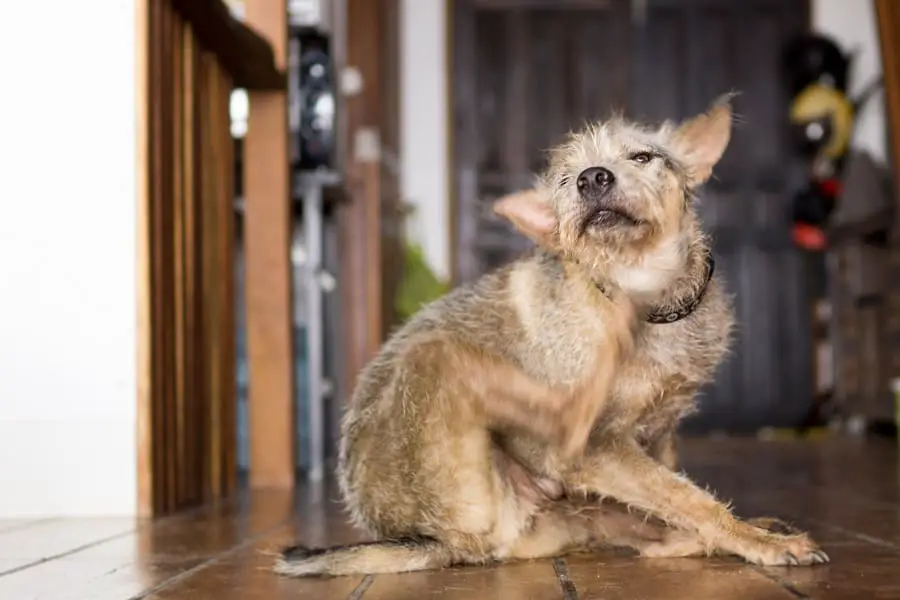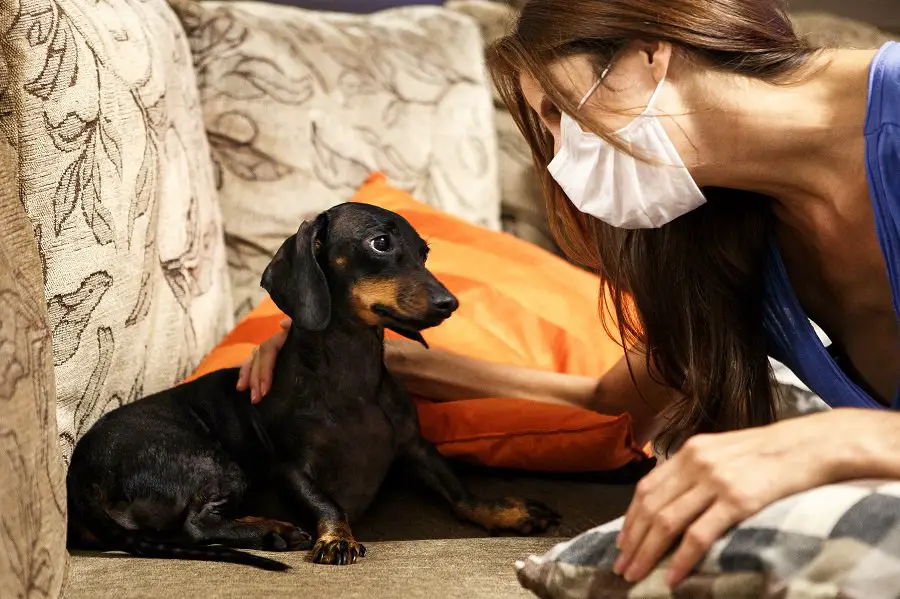For many of us dog lovers, the height of misfortune would be being allergic to our canine pals.
The very idea of not being able to cuddle with our furry friends is downright traumatic.
But this is a reality for many people – in fact, it is as high as 10% of the population in the USA, according to the American College of Allergy, Asthma, and Immunology.
When people with such allergies meet dogs, instead of a sense of joy, they experience wheezing, itchy eyes, a runny nose and incessant sneezing.
It is no wonder then that searches for information on hypoallergenic dogs are so common on Google.
And, once in a while, you will find our dear friend, the Dachshund, a part of such lists too. But are dachshunds really hypoallergenic?
For that matter, are any breeds completely allergen free?
While the issue of allergies caused by dogs merits a slightly nuanced discussion, the simple answer to both the questions above is: No.

Dachshunds are not hypoallergenic, though the different varieties of the breed can have different effects on people with the condition.
In fact, no dog breed is completely safe from the perspective of allergies in humans, though some breeds do seem to cause allergic reactions more often than others.
There are also a few precautions that can be taken to avoid the effects of dog allergens if you or someone in your family is prone to this condition.
So, if you love dachshunds, but are allergic to them, all is not lost.
Allergy Caused by Dogs
It is often believed that dog fur is responsible for allergic reactions in humans.
The result of this misconception is that furry breeds are automatically condemned as allergy-causing and those with short hair are considered safe.
But human beings are not allergic to actual fur. There’s this thing called dander – similar to dandruff in human beings – which is the main culprit responsible for allergies.
Dander can come off on its own or can be attached to the fur shed by a dog.
So, there is a reasonably high chance that a dog that sheds a lot also has more dander coming off its body.
On the other hand, if your dog does not shed, or does do minimally, the dander will not spread freely around in its surroundings.
But there isn’t a direct proportionality involved here.

Dander is produced when the outer layer of the skin, or epidermis, of the dog renews itself.
This thin outer layer is pushed upward as cells from below come up as part of this renewal process.
This typically occurs every 21 days in dogs, and results in dead outer layer cells falling off as dander.
Dander is very light in weight and can remain suspended in air or spread easily in the dog’s vicinity.
Thus, even a low-shedding dog will produce dander, and it could still trigger allergic reactions.
By the way, if you are interested in more information on shedding in dachshunds, here’s a detailed article on it.
Apart from dander, another common allergen in a dog is its saliva, or more precisely, a specific protein found in the saliva of dogs.
These proteins are present in all dogs and their primary mode of spreading is through the saliva sticking to dog hair.
But, dog saliva has other modes of spreading, and if you have ever been lovingly licked by your dog, you know how.
You can already see why the notion of long-haired dogs being more likely to cause allergies is a myth.
There is another important reason that makes clearly identifying any breed as more or less allergy-causing difficult.
There is both anecdotal and scientific evidence that different humans’ bodies react differently to different breeds.
In fact, an allergy-prone human might react differently to two different dogs from the same breed too.
So, a person can be allergic to long haired dogs, short haired dogs or dogs with no hair at all.
Moreover, the amount of dander from a dog can change with age too. Puppies do not have as much old skin to shed as mature dogs.
This makes it possible that a dog that did not trigger any reaction in you when it first came to your home as a pup might still end up being a trigger as it grows older.
If matters were not complex already, there is also rampant cross-breeding among dogs. It cannot be said conclusively if any one breed is completely free from allergens.
Therefore, we contend that this whole business of listing some dogs as hypoallergenic rests on very shaky scientific ground.
Dachshunds and Allergies
There’s this much-cited piece of trivia from US history. President Kennedy, during his younger days in the US Navy, was posted in 1937 in Europe.
He bought a dachshund puppy there for his then girlfriend Olivia. From all accounts, he adored the dog – he had named it Dunker – but had to leave it behind in Germany because he had started to get allergic reactions from the dachshund.
That’s as good an historical proof as any that the breed can cause allergies in humans.
We have seen that there is some relation between shedding of fur or hair and the spread of dander in dogs.
Since dachshunds are small-sized dogs, the volume of fur or dander they leave around is small compared to larger dogs.
The dachshund breed itself is not homogenous, of course. There are three clearly identifiable types, each with a different type of coat.
These three are: short-haired, long-haired, and wire-haired.
All three types shed, but the long-haired variety sheds the most. The short-haired variety also sheds a bit more than the wire-haired one.
But even the wire-haired variety of dachshunds is not hypoallergenic, even though it is, in general, the best option of the three if you are fond of the breed, but have someone in your family who suffers from an allergic condition.
In any case, if you really want a dachshund, but are unsure of its allergic effects, there are certain precautionary measures you can take to minimize the chances of the dog becoming a source of discomfort for you or your family members.
Precautions with Dachshunds
The first step in tackling the issue of allergies caused by dogs is to know where the animal comes from.
The practice of adopting pets from shelters has really caught on these days, and we wholeheartedly support it.
But, because of the unclear antecedents of a shelter dog, you can never be sure if the dachshund you are getting is purebred or has some other dog’s DNA mixed with it.
What you can do is get your dachshund from a breeder or a rescue group that specializes in the breed.
Once you have selected a dog at the breeder’s, you can also check if the dog is safe for you (or the family member concerned) before bringing it home.
Visit the breeder without interacting with any other dog on the way. Spend about 30 minutes with the dog at the breeder’s place.
If you have an allergic reaction within this period, it’s clear that the dog is not safe for you.
If nothing happens, come back home and keep away from any other dog for the next few hours.
When you do not experience even a delayed allergic reaction, you know that the dachshund is safe for you as a pet.
This process will work, of course, if the breeder has only dachshunds with him.
If there are other dogs interacting with the dachshund you are checking out, you could be getting exposed to allergens from those dogs, making the test inconclusive.

Here are some other tips you should seriously consider if you have a history of dachshund allergies, but want to own one as a pet:
-Invest in air purifiers that are effective against pet dander. You might need more than one in your home, depending on the size of the home, ventilation, etc.
-Use specially designed pet vacuum cleaners that can absorb dander and hair falling off from dogs’ bodies.
-Keep the surfaces in your home and at your workplace sanitized. Regular cleaning reduces the amount of dander that enters your system.
-Bathe your dachshund frequently using anti-allergenic shampoos. A bath once every 3 weeks or so can reduce harmful dander substantially.
-Talk to a physician specializing in allergies about ways to tackle dog allergens. A doctor familiar with your allergy history can suggest critical measures you can take to make life with your dachshund comfortable.
Allergists sometimes suggest leaving dogs outside the house, often in a separate doghouse or shed.
This might just work with some other breeds, though no dog enjoys staying away from its human family.
But, this is a strict no-no with dachshunds. These are extremely social animals and leaving them on their own for long periods will turn them depressive.
Key Points
-Dachshunds are not hypoallergenic, but then, no breed of dog can be considered completely hypoallergenic.
-There are some traits, like low shedding in the wire-haired variety, which make dachshunds relatively safer for people with allergies to dogs.
-If you take certain precautions, you can minimize the risk of a severe allergic reaction in you or someone dear to you.
-This means that, even if you are allergic to dogs, you don’t have to deprive the dog lover in you.
